|
Week 4: August 22-28, 2011 |
Welcome
to the McGill Bird Observatory weekly report.
Click here for a complete listing of our archives.
Comments or
questions are welcome at "mbo AT migrationresearch.org".
|
PICTURE
OF THE WEEK: |
|
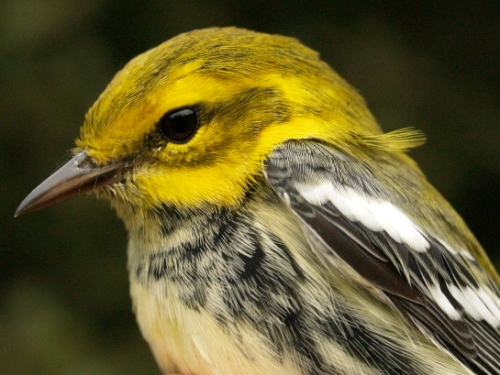
Black-throated Green Warbler migration at MBO usually peaks in September; the five
banded this week (including the one above)
was a record for any week in August.
(Photo by Simon Duval)
-
|
|
|
THIS WEEK |
THIS FALL |
2011 TOTAL |
SITE TOTAL |
|
# birds (and species) banded |
240 (37) |
772 (52) |
1860 (74) |
33429 (108) |
|
# birds (and species) repeat |
42 (14) |
171 (27) |
326 (37) |
5833 (68) |
|
# birds (and species) return |
2 (2) |
11 (7) |
106 (20) |
913 (37) |
|
# species observed |
77 |
97 |
141 |
202 |
|
# net hours |
426.0 |
2023.5 |
4860.5 |
54477.6 |
|
# birds banded / 100 net hours |
56.4 |
38.2 |
38.3 |
61.3 |
|
|
Note: table does not include nocturnal banding (owls) |
|
Bander-in-charge: Simon Duval, Gay Gruner
Assistants: Christine Barrie, Nicolas Bernier, Sue Bishop, Rui de Jesus, Jean Demers, Nicki Fleming, Maryse Forest-Tremblay, Barbara Frei, Alison Hackney, Frédéric Hareau, Lima Kayello, Lisa Keelty, Barbara MacDuff, Benoit Piquette, Francine Piquette, François Rousseaux, Ahmad Shah, Clémence Soulard, Patricia Stotland, Elise Titman, Rodger Titman
Notes: After two unusually quiet weeks, we were happy to see a substantial increase in bird migration this week. The 240 birds banded this week is actually a record high count for week 4, despite (or perhaps because of?) some unsettled weather that limited us to minimal banding effort on Monday and Thursday, and also reduced our hours a bit on Sunday. Taken together, that resulted in our birds banded per 100 net hours being almost exactly double what it was last week. Much of this was thanks to a spectacular Friday morning, when we banded 112 birds of 28 species, both record highs for August by a wide margin. This included a particularly impressive 90 individuals of 17 warbler species. Surprisingly this wasn't linked to a major cold front; temperatures on Friday were only a few degrees cooler than the day before.
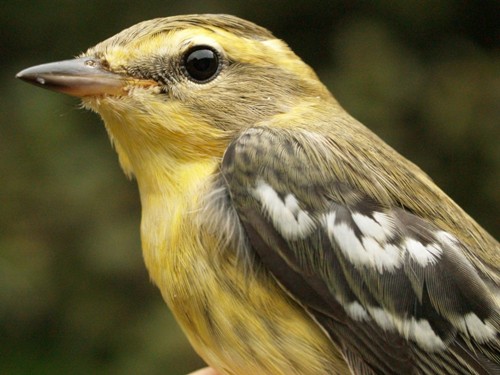
Roger Tory Peterson popularized the term "confusing fall warblers" and this pair of photos highlights a couple of the classic examples - a Blackburnian above, and a Blackpoll below. Although they are superficially quite similar, notice the more distinct yellowish supercilium on the Blackburnian, compared to the somewhat faint dark eyeline that is the most distinct feature on the Blackpoll's face. Also the Blackburnian is a bit more yellowish, compared to the lightly greenish tone of the Blackpoll.
(Photos by
Simon Duval)
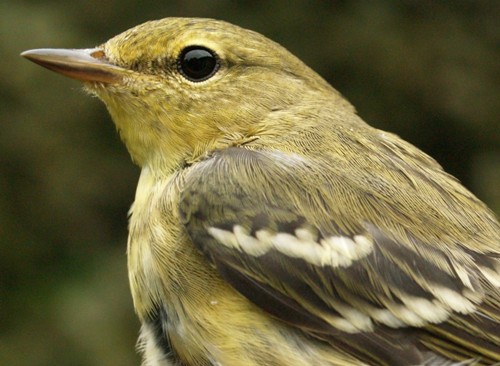
|
While numbers banded this week were great, observations remained a bit below average, with 77 species reported this week, bringing the cumulative total for the season up to 97, whereas from 2005 through 2009 we had reached triple digits by this time of year. The nine species added to the fall 2011 list this week were Common Loon, Sharp-shinned Hawk, Herring Gull, Common Nighthawk, Philadelphia Vireo, Brown Thrasher, and a trio of "B" warblers (Blackpoll, Bay-breasted, and Blackburnian). The nighthawk was our first of the year, and only the fourth ever observed at MBO; all sightings have occurred in the second half of August. Among the influx of migrants to our nets this week were three species banded for the first time this year (Philadelphia Vireo, Blue Jay, and Blackburnian Warbler), and four others for the first time this fall (Sharp-shinned Hawk, Blackpoll Warbler, Bay-breasted Warbler, and Black-throated Green Warbler). All three of the species banded for the first time in 2011 came during our big Friday.
This week’s top 10 [last week's rank in brackets]
# individuals banded |
mean # individuals observed daily |
1. Magnolia Warbler (43) [10] |
1. Cedar Waxwing (25) [1] |
2. American Redstart (31) [1] |
2. Red-winged Blackbird (19) [-] |
3. Tennessee Warbler (23) [7] |
3. Black-capped Chickadee (17) [2] |
4. Chestnut-sided Warbler (15) [-] |
4. American Crow (17) [4] |
5. Ovenbird (12) [5] |
5. Common Grackle (16) [-] |
5. Common Yellowthroat (12) [3] |
6. American Goldfinch (14) [6] |
7. Nashville Warbler (9) [10] |
7. American Robin (14) [5] |
7. Song Sparrow (9) [2] |
8. American Redstart (10) [7] |
7. Indigo Bunting (9) [-] |
9. Blue Jay (8) [-] |
10. Black-capped Chickadee (6) [10]
10. Black-throated Blue Warbler (6) [-]
|
10. Magnolia Warbler (8) [-] |
|
Magnolia Warblers were the most frequently banded species in week 4 in five of six previous fall seasons at MBO, and this year stayed true to the pattern, with a sharp increase in numbers from last week. American Redstart is getting to be almost as predictable, coming in as the runner-up for week 4 for the fifth consecutive year. More of a surprise was Tennessee Warbler, of which we've never before banded more than 10 at this time of year, so this suggests they're either early this fall, or might be coming in larger than usual numbers. Even more surprising was the count of 15 Chestnut-sided Warblers, a single-week record for MBO (and more than we banded in the entire 2006 or 2007 fall seasons). The warbler domination continued with good numbers of Ovenbirds and Common Yellowthroats, and a slight increase from last week for Nashville Warbler, plus Black-throated Blue Warblers barely making it on the list in a tie for tenth place. The only others to crack the top ten this week were Song Sparrow and Indigo Bunting in a tie for seventh, and Black-capped Chickadee hanging on in tenth place for a third week in a row.
In terms of species observed, Cedar Waxwing maintains its atypical dominance for another week. The biggest surprise here though was the return of Red-winged Blackbirds, usually quite scarce in late August (a mean of fewer than 5 per day over the previous six years). With them were Common Grackles, also vaulting back into the top five this week, although a bit less unusual for this time of year. The grackles split apart last week's cluster of Americans, with American Crow staying in fourth place for yet another week and American Goldfinch hanging on at number six, but American Robin and American Redstart dropping down to seventh and eighth place respectively. Blue Jay and Magnolia Warbler were new entries at the bottom of the list. This marks the first year ever that Song Sparrow has not been in the top ten at this point in fall, despite being the third most numerous last week. Others dropping off were last week's "bottom three" (Common Yellowthroat, Red-eyed Vireo, and Ruby-throated Hummingbird).
After four weeks, our overall numbers for the season are close to average, but the excitement of the past few days has us hopeful that a further influx of warblers will soon be coming our way. Our top three species banded so far this fall are American Redstart (98), Song Sparrow (80), and Yellow Warbler (75), but with more than two-thirds of the season yet to come, we know that list will change substantially before we're done.
|
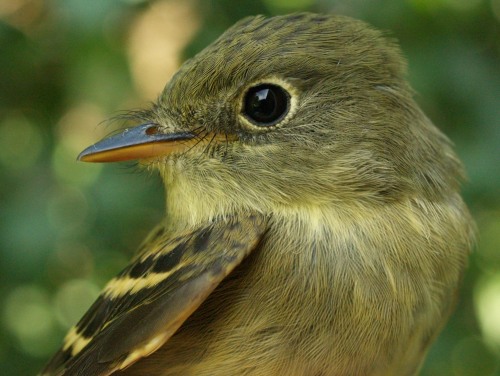
Although warblers were the story of the week, we did band a variety of other species too. Notable among them were the Yellow-bellied Flycatcher above (an August specialty at MBO), and the young Chipping Sparrow below (a species we rarely band until the second half of fall).
(Photos by
Simon Duval)
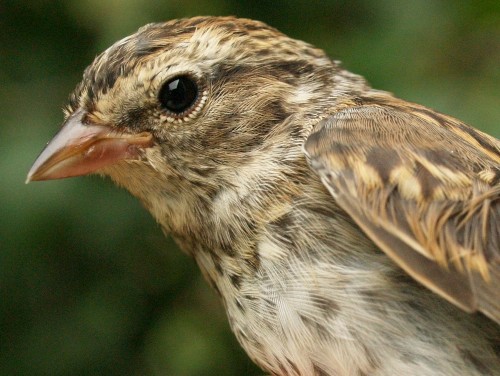
|





